1. The Hadal Snailfish: The Deepest Dweller Ever Recorded
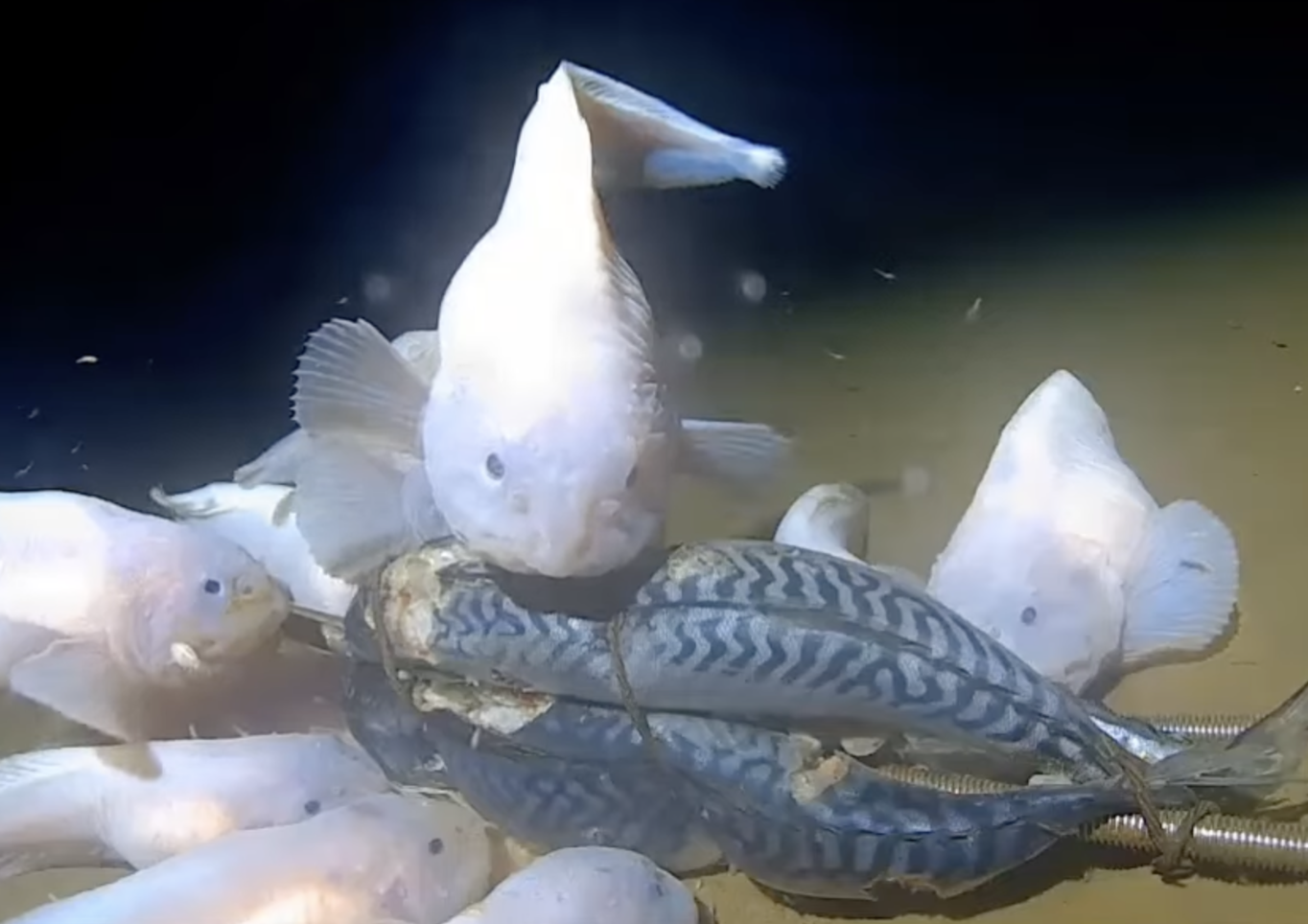
At the very bottom of the ocean, in the pitch-black folds of the Mariana Trench, lives a tiny, ghost-white fish that somehow survives what should be impossible. It’s called the snailfish, and scientists have filmed it swimming calmly more than 26,800 feet down, which is over five miles beneath the surface, where the water pressure is so intense that it would crumple a steel submarine like an empty soda can.
This little creature doesn’t have the bones or air bladders that most fish use to float. Instead, it’s soft and squishy, more like jelly than flesh, built to endure the weight of an entire ocean above it. In 2017, researchers dropped cameras into the trench and watched in disbelief as this pale fish drifted past, completely at home in a world colder than ice and darker than any cave. Its body chemistry seems to keep its insides from collapsing under pressure. It’s not just surviving down there. It’s thriving where life shouldn’t even be possible. Source: Natural History Museum
2. The Amphipod That’s Been Eating Plastic at the Bottom of the World
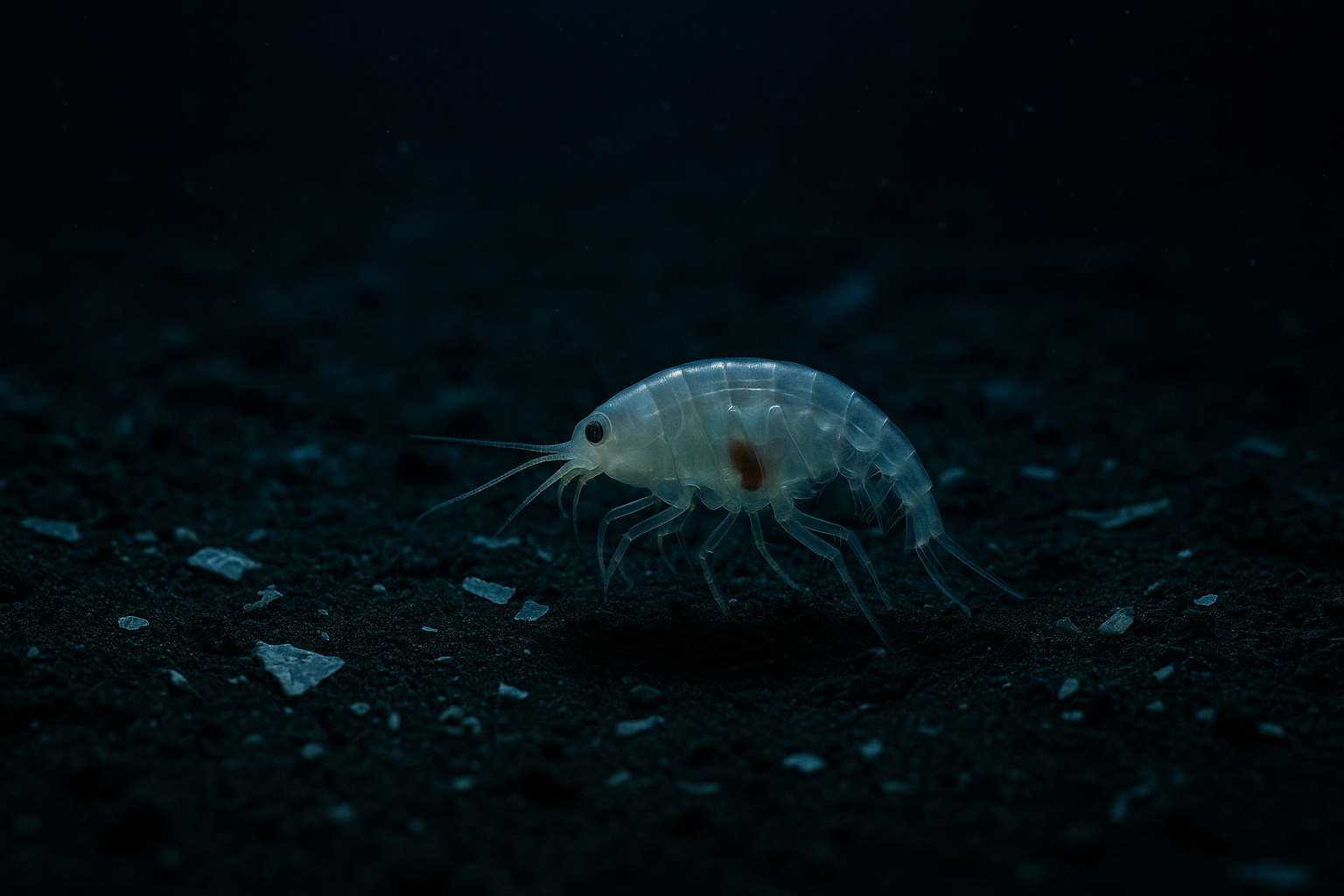
Deep beneath the surface, where sunlight never touches and the pressure could crush a train car, lives a shrimp-like scavenger that might outlast us all. It’s no bigger than a thumb, but the Mariana Trench amphipod doesn’t just survive down there, it thrives on the leftovers of the world. Everything that dies and sinks eventually becomes its dinner, from fish bones to whale skin to, disturbingly, our plastic waste. In 2014, when a British team sent a lander nearly seven miles down, they discovered these tiny creatures feasting on debris, including a surprisingly intact candy wrapper.
What shocked scientists even more was what they found inside them. Amphipods had microplastics lodged in their stomachs, proof that pollution has reached even the deepest point on Earth. One species was even named Eurythenes plasticus to highlight the crisis. These creatures can withstand extreme cold and pressure, but now they’ve also adapted to our garbage. They’ve become accidental evidence that nothing, not even the farthest corners of the ocean, escapes the reach of human impact. Source: Oceanographic
3. The Barreleye Fish with a Transparent Head
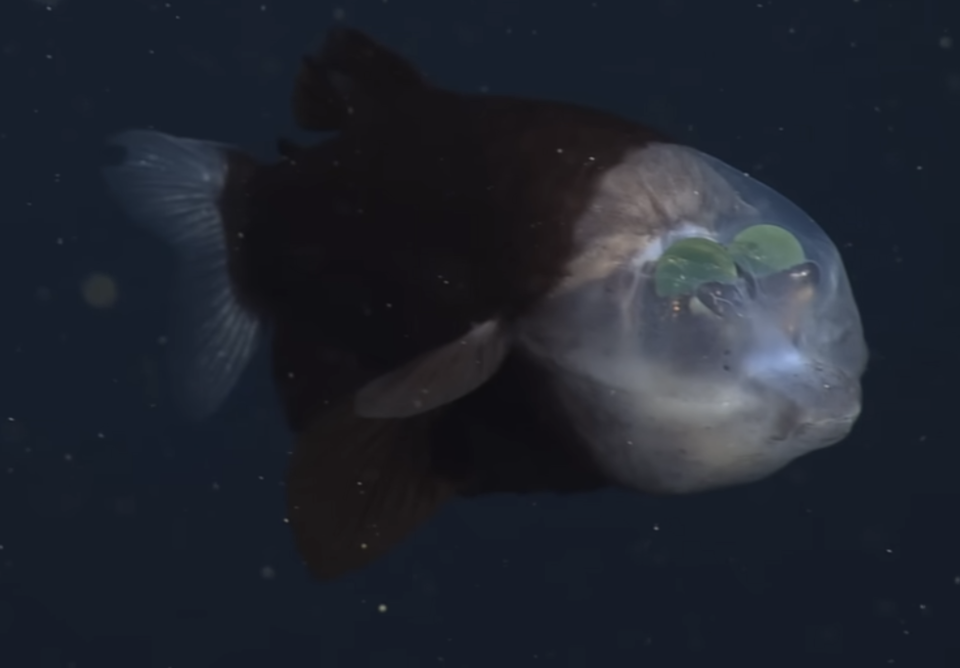
It looks like something out of science fiction, but the barreleye fish is very real and it’s one of the strangest creatures ever found in the deep. Floating silently in the inky dark, this fish has a see-through head like a glass dome. Inside, two green, glowing barrel-shaped eyes stare upward through its skull, scanning for the silhouettes of prey. First discovered in the 1930s, it wasn’t until 2004 that scientists actually filmed a living one, drifting deep off the coast of California at depths over 2,000 feet.
The barreleye doesn’t need to chase its food. It stays motionless, waiting in the freezing quiet while its eyes track jellyfish and drifting worms above. When it sees something edible, it makes a slow, eerie rise. That transparent dome isn’t just creepy, it helps shield its eyes from jellyfish stings and light distortion. In a place where seeing is surviving, this fish turned its whole head into a pair of binoculars. Source: BBC Wildlife
4. The Dumbo Octopus That Floats Like a Ghost
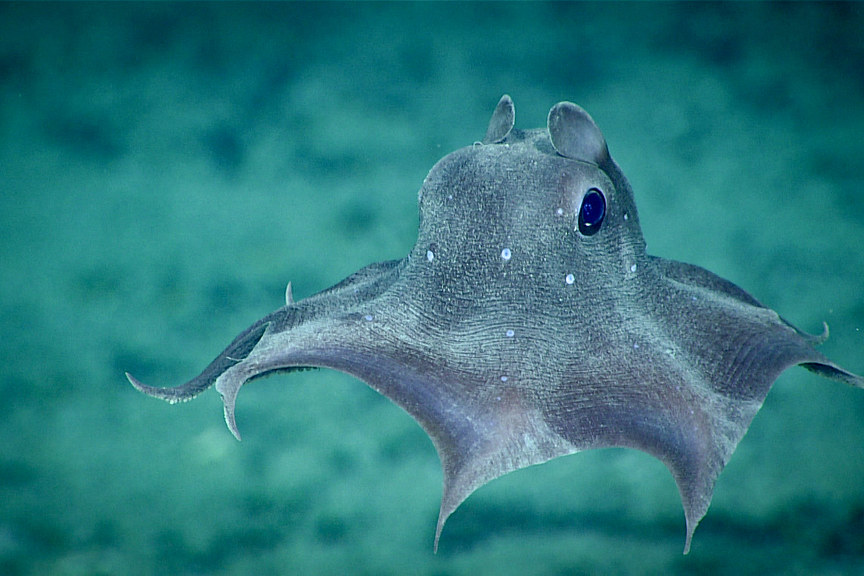
At more than 13,000 feet below the surface, you wouldn’t expect to find anything remotely cute. But then along glides the dumbo octopus, flapping its ear-like fins and drifting like a ghost through the freezing dark. It’s named after Disney’s Dumbo because of those oversized fins, but this deep-sea octopus is anything but silly. It lives in total darkness, far below where most submarines dare to go, and it floats without any need to jet or squirm. Its soft, gelatinous body can handle the crushing pressure of the deep, and it doesn’t even need an ink sac; there’s no use for one where predators rarely follow.
Unlike other octopuses, it doesn’t crawl along the seafloor. Instead, it hovers and pulses upward in slow motion, scanning for worms and small crustaceans. Scientists have filmed them as deep as 23,000 feet, that’s more than four miles down, deeper than Mount Everest is tall. And when it moves, it does so with quiet grace, like a silk scarf drifting through oil. There are at least 15 known species of dumbo octopus, and every sighting reminds researchers just how surreal deep ocean life can be. Source: CBC
5. The Giant Amphipod Wrapped in Armor
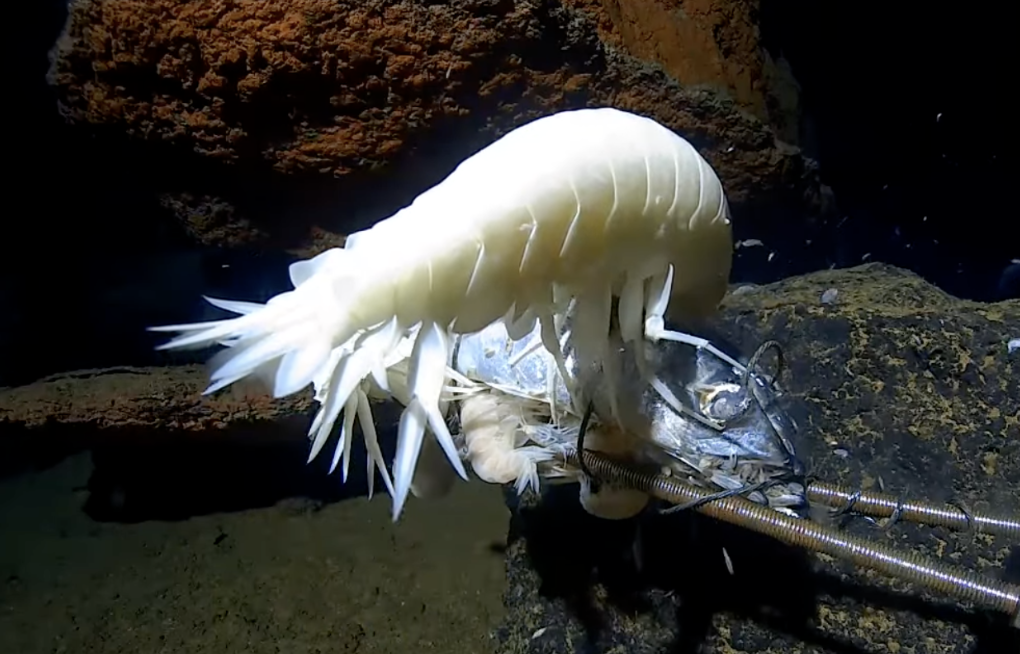
It looks like a bug from another planet, and in many ways, it is. The giant amphipod lives miles beneath the ocean surface, in places so cold and dark that time seems to stop. It’s about ten times larger than its shallow-water cousins, stretching up to six inches long. That might not sound huge until you realize most amphipods are smaller than a fingernail. Down in the trench, it wears a hard, almost metallic shell, giving it the look of a creature carved from ancient stone. Scientists believe it evolved this armor to survive in a world with no escape from pressure or predators.
When researchers first spotted one near the Mariana Trench in 2011, they were stunned. It wasn’t just its size, but its prehistoric look, as if it belonged in a fossil record rather than a live trap. The creature’s stomach contents included wood, suggesting it feeds on sunken debris from storms and shipwrecks far above. It survives in silence, scavenging in slow motion, armored against the weight of an entire world pressing down from above. Source: MBARI
6. The Fangtooth Fish That Looks Like a Deep-Sea Demon
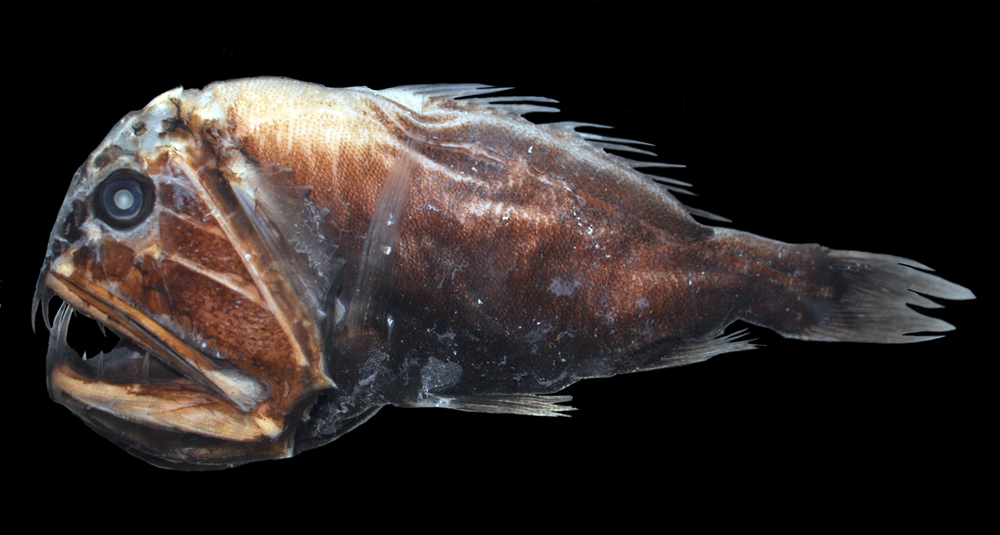
If nightmares had gills, they might look like the fangtooth. This small but terrifying fish lives more than 16,000 feet below the surface, where the sun doesn’t reach and predators take on monstrous forms. Despite its size, it rarely grows longer than six inches; its teeth are so enormous they can’t even fit in its mouth properly. Fangtooths have the most significant teeth-to-body ratio of any fish alive. Their lower fangs are so long that they need special pockets in the upper jaw to close their mouths.
Their dark, almost charred skin and sunken eyes give them the look of something fossilized rather than alive. But make no mistake, these fish are hunters. They roam the depths in search of anything they can fit in their jaws, from smaller fish to crustaceans. Scientists have recorded them surviving in both the abyssal and hadal zones, showing up at depths of over 3 miles in the open ocean. Their bodies are tough, their movements slow, and their appearance unforgettable. In a place where even light dies, the fangtooth thrives in pure darkness. Source: MBARI
7. The Sea Cucumber That Eats Mud at the Bottom of the Trench
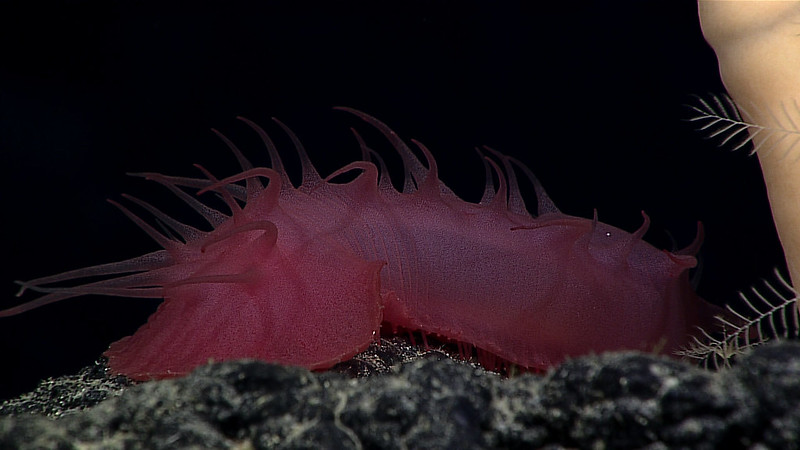
It doesn’t have teeth. It doesn’t have eyes. And it doesn’t seem to do much. But the sea cucumber is one of the most essential creatures crawling along the deepest parts of the ocean floor, including the very bottom of the Mariana Trench. At nearly 36,000 feet, where even light waves can’t survive, these strange, squishy animals glide slowly over the seafloor, vacuuming up the mud. What they’re doing is recycling the ocean’s leftovers. Every flake of dead plankton, every speck of decaying matter that drifts down from above, ends up in their soft, tube-like mouths.
What’s even more incredible is that they survive in a place so pressurized that their bodies would flatten without their strange, pliable makeup. Scientists captured footage of these creatures near Challenger Deep using deep-sea landers, and one species even uses water-filled cavities to change shape, shrinking, stretching, and flowing like a bag of liquid. They’re part janitor, part shape-shifter, and utterly vital to keeping Earth’s most remote ecosystem alive. They don’t need to see or chase. They need to keep crawling through the darkness. Source: NOAA
8. The Zombie Worm That Feeds on Whale Bones
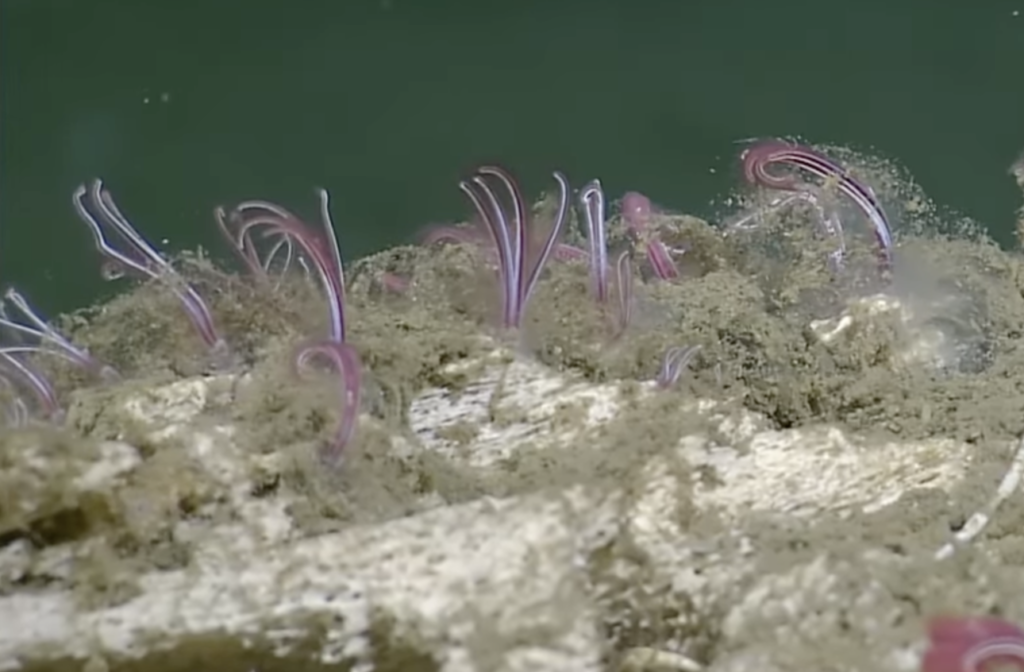
In the deepest trenches of the ocean, where food is scarce and sunlight has never touched the seafloor, some creatures survive on what’s left behind, long after life has ended. The zombie worm, also known as Osedax, lives off the bones of dead whales that have sunk to the bottom. When a whale carcass falls to the ocean floor, a rare but massive event, zombie worms swarm in. They don’t have mouths or stomachs. Instead, they release acid through their skin to break down the bone, then absorb the nutrients using root-like tendrils that burrow deep into the skeleton.
These worms have been found as deep as 10,000 feet, and some researchers believe they exist even farther down in trenches like the Mariana. The name “zombie worm” fits not just because they live off the dead, but also because they resemble the undead. Females are bright red and feathery, while males are microscopic and live inside the females’ bodies, doing little else but fertilizing eggs. They live in total darkness, thrive on death, and help clean the seafloor one bone at a time. Source: Smithsonian Ocean
9. The Grenadier That Waits in the Shadows
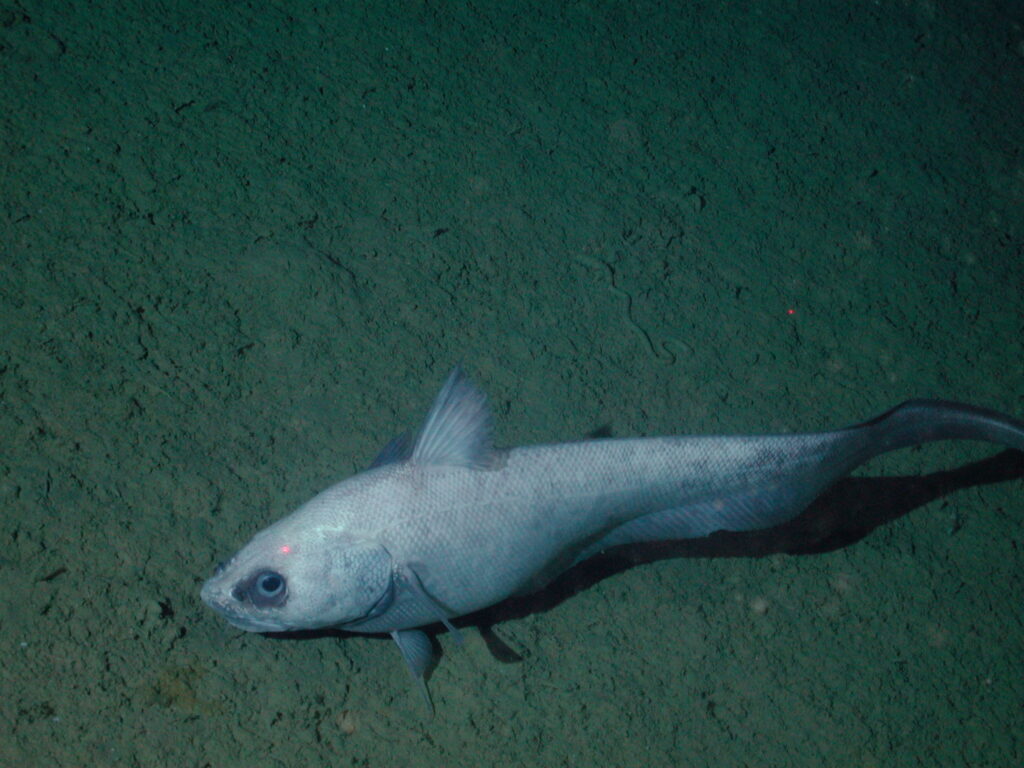
With its oversized head, sunken eyes, and long trailing tail, the grenadier looks like something pulled from ancient folklore. These deep-sea fish, also called rattails, are some of the most common vertebrates in the abyss, showing up on submersible cameras as deep as 20,000 feet. Their bodies are oddly proportioned, huge heads make up nearly a third of their total length while their flesh is soft, almost sponge-like, a necessity in a world where pressure could collapse a car. Despite their eerie appearance, grenadiers play a crucial role in the trench ecosystem, constantly scanning for carrion drifting down from above or disturbing the seabed with their sensitive barbels to uncover hidden prey.
But what makes them so remarkable isn’t just survival, it’s longevity and strategy. Some grenadiers live over 50 years, possibly much longer in the trench where metabolism slows to a crawl. They often gather around hydrothermal vents and methane seeps, places where other creatures are drawn, turning the grenadier into a patient opportunist. They’ve been filmed hovering just inches above the bottom, wasting no energy, letting gravity do the work. In one NOAA dive, a grenadier stayed in the camera’s frame for nearly half an hour, barely moving. That kind of stillness isn’t laziness, it’s expert engineering for a place where food might not appear for days or weeks. Source: California Sea Grant
10. The Lizardfish That Hunts in the Black
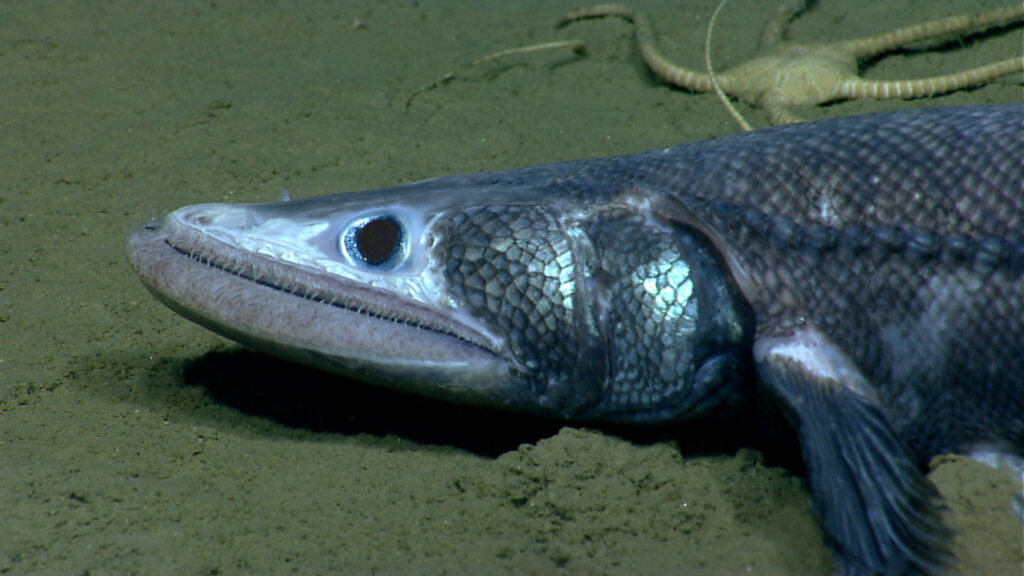
The deep-sea lizardfish isn’t built to charm. It’s lean, grayish, and low to the ground, but in the hadal world, it’s a nightmare with a pulse. Found crawling the bottom at depths reaching 20,000 feet, this predator lies buried or still, its glassy eyes tilted upward. It’s one of the few fish down there with functional eyes, but it doesn’t need vision alone. Vibration-sensitive nerves along its body let it “see” movement even in pitch blackness. And when it’s time to strike, its mouth opens to reveal needle-fine teeth curved backward like fishhooks, ensuring that once something goes in, it never comes out.
What’s surprising is how much this fish can swallow. Its stomach stretches wide enough to engulf prey nearly its own length, sometimes more. Scientists suspect it feeds rarely, but massively, gorging on crustaceans, cephalopods, or anything unlucky enough to pass overhead. In one deep dive near the trench, researchers caught footage of a lizardfish lunging for a baited lander, jaws snapping open like a bear trap. Its slow, deliberate existence masks a lightning-fast attack. In a world with no second chances, it’s not the biggest fish that survives; it’s the one that waits best in total darkness. Source: Smithsonian Ocean
11. The Dragonfish That Makes Its Own Red Light
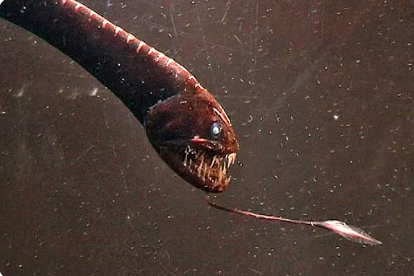
The dragonfish looks like it was dreamed up in a horror movie, sleek, black-scaled, and armed with dagger-like teeth that jut from its mouth like needles. But the most haunting thing about it isn’t its grin. It’s the light it produces. While many deep-sea creatures glow blue or green, the dragonfish is one of the only animals in the world that creates its red bioluminescence. Down past 6,000 feet, red light doesn’t exist—it gets filtered out by water much higher up, so most sea creatures can’t see it. That gives the dragonfish a terrifying advantage: it can shine a light only it can see, turning the pitch-black water into its hunting ground.
It uses this invisible flashlight to spot prey without being spotted itself. Lurking in the depths just above the trench, it waits for the faintest flicker of motion, then lunges with lightning speed. It also has a chin barbel, a glowing lure that dangles below its mouth to tempt smaller fish and shrimp. When something comes close, the dragonfish snaps its jaws so fast it creates a miniature vacuum, pulling the victim straight in. Some species can live at pressures found at over 16,000 feet, with flexible skulls and no swim bladder to implode. In the deep sea, stealth is survival, and the dragonfish hunts with a secret weapon no one else can even see. Source: Woods Hole Oceanographic Institute
12. The Tripod Fish That Stands on the Seafloor
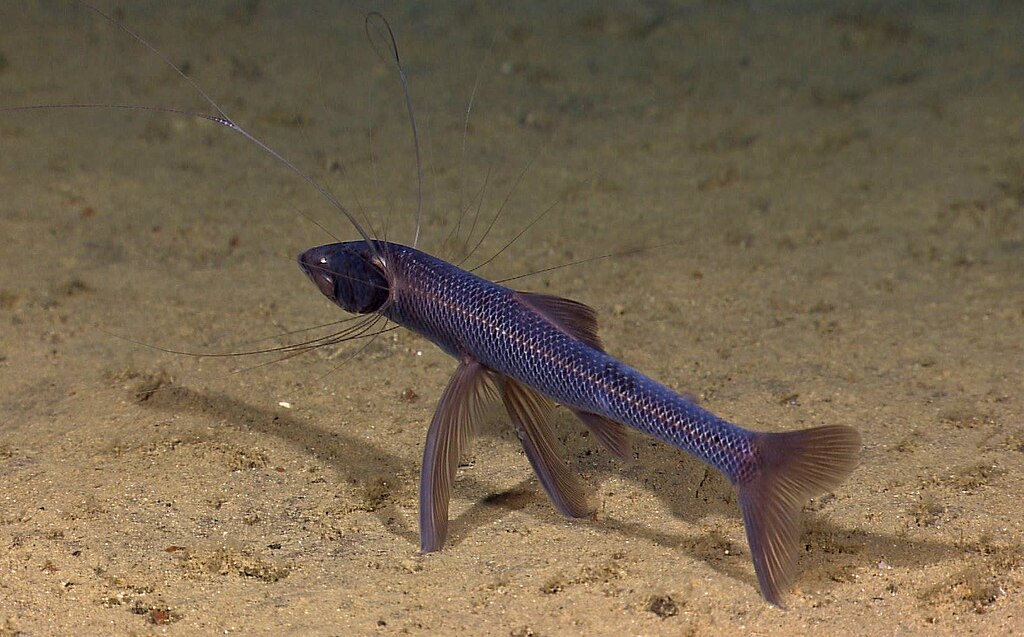
Most fish swim. This one stands. The tripod fish is one of the few animals in the world that uses its bones like stilts, balancing on three spindly fins as it faces into the deep-sea current. Found at depths beyond 15,000 feet, including the muddy plains near the Mariana Trench, it plants itself in one spot and waits for dinner to drift by. Its stiff tail fin and two long pelvic fins touch the seafloor while the rest of its body hovers eerily still, unmoving in the pitch-black water. With eyes that barely function in the darkness, it relies on long, ultra-sensitive pectoral fins held out like antennae to sense prey.
It doesn’t chase, lunge, or fight. It simply waits. The current brings tiny shrimp, worms, and plankton floating past its face, and with a flick of its jaw, the tripod fish snaps them up. Some can go hours without moving, conserving energy in a place where meals are rare and competition is ruthless. What’s even stranger is that many of these fish are hermaphrodites; they carry both male and female reproductive parts, allowing them to reproduce even if they never meet another fish. That’s essential in the trench, where neighbors can be miles apart. In a world where nothing lasts and everything is scarce, the tripod fish found a way to stand its ground, literally. Source: Australian Geographic
13. The Deep-Sea Jellyfish That Lights Up Like a UFO
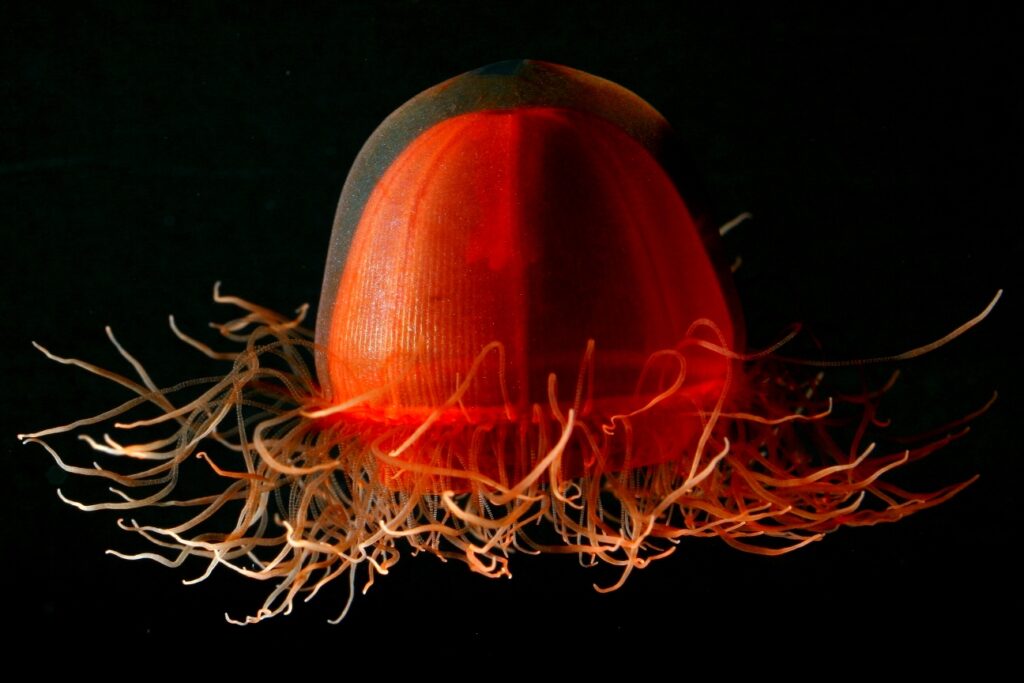
In the deepest reaches of the ocean, even jellyfish become something otherworldly. In 2016, researchers from NOAA’s Okeanos Explorer captured footage of a glowing jellyfish at over 12,000 feet near the Mariana Trench, and what they saw looked more like a spacecraft than a sea creature. It hovered silently in the water, its translucent bell illuminated by two glowing rings, one red, one yellow, giving it the eerie look of a floating saucer. This jellyfish, believed to be a species of Crossota, didn’t pulse like the jellies we know from the surface. It stayed completely still, tentacles outstretched, as if waiting in ambush.
What makes this jellyfish especially strange is that it doesn’t have a medusa stage like most jellies. It stays in its drifting adult form for life, never attaching to the seafloor. Scientists believe it uses its bioluminescence both to lure prey and confuse predators. Its lights can flash suddenly, vanishing into the dark in an instant. In the trench, where movement usually means danger, stillness can be the perfect disguise. The footage taken during that dive was so stunning that it went viral among scientists because even for the deep sea, this jellyfish was unlike anything they’d ever seen. Source: Live Science
14. The Cusk-Eel That Hides in Total Silence

It might be called an eel, but the cusk-eel isn’t slimy or slithering; it’s a thick-bodied, pale creature built for the pitch-black seafloor. These elusive fish are often spotted near trench walls and abyssal plains at depths below 16,000 feet, buried halfway in the mud with just their heads poking out. They’re masters of stillness, moving only when absolutely necessary. Their flesh is soft, their skeletons lightly calcified, and their bodies adapted to survive in pressure that could flatten a car. Scientists have captured footage of cusk-eels lying motionless for hours, conserving energy in a world where even a short sprint could be deadly.
What’s most haunting is the way they hunt. They wait silently, sometimes entirely buried except for their upward-facing jaws. When a shrimp or worm comes near, the cusk-eel strikes in a flash, then sinks back into the silt. Many species are hermaphrodites, able to self-fertilize or swap roles with the only other fish they might meet in a year. Some grow to over three feet long, though most remain modest in size. In the trench’s unforgiving landscape, this fish survives not by outswimming its rivals, but by vanishing into the background and waiting as long as it takes. Source: Britannica
15. The Coffinfish That Holds Its Breath Under Pressure
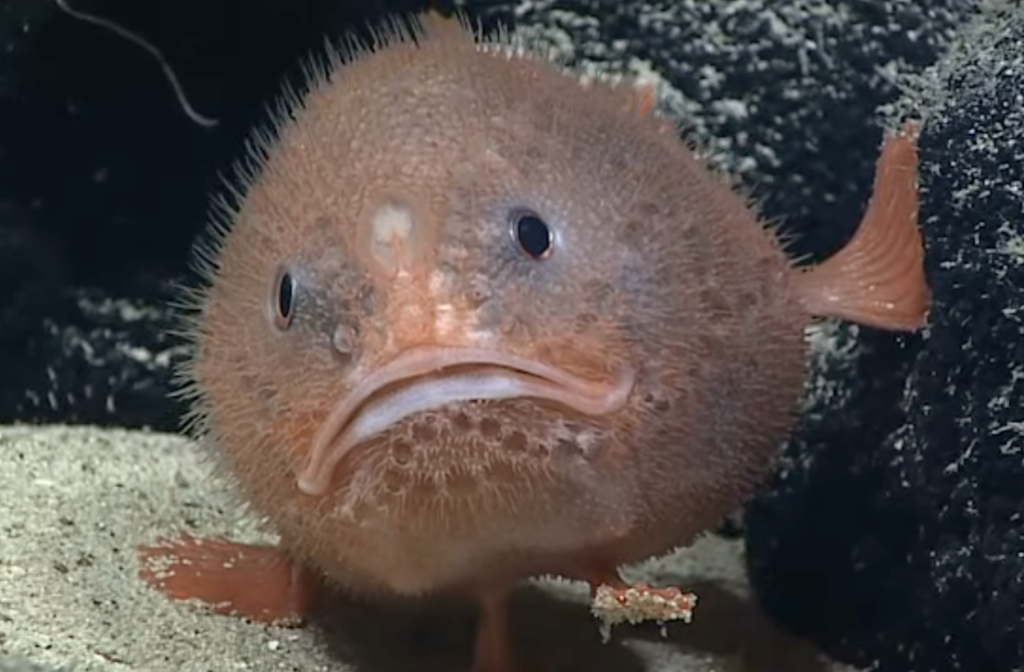
The name alone sounds like a warning. The coffinfish lurks in the deep, shaped like a deflated balloon with a grim expression and a body that seems more blubber than bone. Found at depths over 6,500 feet and believed to go much deeper, it’s part of a bizarre family of deep-sea anglers that survive through disguise, trickery, and one of the strangest defense mechanisms in the animal kingdom. When threatened, the coffinfish can suddenly puff up its body with water, inflating like a fleshy pufferfish to nearly double its size. However, that’s not all; it can also hold its breath for several minutes, closing off its gill slits entirely a move scientists suspect helps it conserve energy and avoid detection.
It sits perfectly still on the ocean floor, luring prey with a tiny, barely visible filament that dangles in front of its mouth. When something wanders close, it strikes with surprising speed, then returns to its slack-bodied rest. Its skin is soft and loose, almost gelatinous, allowing it to withstand intense pressure without injury. Researchers have spotted them near the trench’s upper slopes, often slumped like forgotten sacks on the seabed, until they swell into action. In the darkest parts of the ocean, where nothing behaves like it should, the coffinfish is a master of slow-motion surprise. Source: Smithsonian Magazine
Final Take: Built for a World That Shouldn’t Exist

At nearly seven miles down, the Mariana Trench feels more alien than any other place on Earth. There’s no light, no warmth, and no pressure so crushing it could flatten the hull of a battleship. And yet, life persists not just barely, but brilliantly. These fifteen creatures don’t just endure the impossible. They’ve evolved to own it. With glowing lures, jelly-like bones, and instincts honed in total silence, they survive in a world we’ve barely begun to understand.
Every dive into the trench reveals something stranger, quieter, tougher. From jellyfish that light up like spacecraft to worms that live off death itself, the trench isn’t empty; it’s teeming with life adapted to a reality we can’t replicate on land. In a way, these animals aren’t just surviving the deep. They’re thriving in the most extreme, hostile, and untouched wilderness on the planet. And for now, they do it far beyond our reach.
This story, 15 Creatures That Survive the Impossible Depths of the Mariana Trench was first published on dailyfetch.net.


